
\[f \circ g \circ G = f(g(G(x))\] \[\left| g \circ G \right|\] \[\left| G(x)^2-9 \right|\] \[\left| \left(\frac{1}{x-5}\right)^2-9 \right|\] \[\left| \left(\frac{1}{x-5}\right)\left(\frac{1}{x-5}\right)-9\right|\] \[\left| \left(\frac{1}{x^2-10x+25}\right)-9\right|\]
Finding the domain: We need to find the points in which the function is undefined. This will be the zeroes of the quotient inside the absolute value: \[\frac{1}{x^2-10x+25}=0\] \[\frac{1}{(x-5)(x-5)}=0\] The zeroes of the denominator give the undefined points: \[x-5=0\] \[x=5\] Turning this into a domain \[(-\inf,5)\cup(5,\inf)\]
from matplotlib import pyplot
import numpy
import math
%matplotlib inline
x=numpy.arange(-5, 11, 0.05)
h = lambda u: numpy.cbrt(u-3)
hfun = numpy.vectorize(h)
y=hfun(x)
fig=pyplot.figure()
ax=fig.add_axes([0,0,1,1])
ax.plot(x,y)[<matplotlib.lines.Line2D at 0x7f2f1dbb3ee0>]
Determining the domain of \(h(u)\) involves understanding the nature of the function. Cube root functions will always have a domain of \((-\infty,\infty)\), and they will always have a range of \((-\inf,\inf)\). Shifts can be applied, but they do not change these results. Domain: \((-\infty,\infty)\) Range: \((-\infty,\infty)\)
First off, the domain needs to be found. This can be easily found by using the quadratic formula as the equation does not look particularly factorable. \[\frac{-96\pm\sqrt{96^2-4(-16)(128)}}{-32}\]
\[\frac{-96\pm\sqrt{96^2-4(-16)(128)}}{-32}\]
\[\frac{-96\pm\sqrt{17408}}{-32}\]
\[\frac{-96\pm\sqrt{1024}\sqrt{17}}{-32}\]
\[\frac{-96\pm32\sqrt{17}}{-32}\]
\[3\pm\sqrt{17}\]
This yields two different solutions:
\[3+\sqrt{17}\] \[3-\sqrt{17}\]
Only one of these solutions is actually in the solution domain \((0,\infty)\), \(3+\sqrt{17}\). This means that an appropriate domain for \(h\) is \(\left[0,3+\sqrt{17}\right]\).
from matplotlib import pyplot
import numpy
import math
%matplotlib inline
x=numpy.arange(0, 3+math.sqrt(17), 0.03)
h = lambda t: -16*t**2+96*t+128
hfun = numpy.vectorize(h)
y=hfun(x)
fig=pyplot.figure()
ax=fig.add_axes([0,0,1,1])
ax.plot(x,y)[<matplotlib.lines.Line2D at 0x7f2f1e074850>]
Now, we need to find when the rocket reaches its highest point. We can do this by finding the vertex using the \(x=\frac{-b}{2a}\). Plugging in the values from the function: \[x=\frac{-96}{2(-16)}\] \[x=\frac{-96}{-32}\] \[x=3\] The rocket reaches the highest point at \(x=3\). Plugging this into the formula to find out the height at this point: \[-16(3)^2+96(3)+128\] \[-16(9)+288+128\] \[272\] The rocket reaches its highest point of 272ft when \(x=3\).
Evaluate the following expression by drawing the unit circle and the appropriate right triangle. \[\tan{\frac{11\pi}{6}}\]
Use the vertical line test to determine whether graphs A, B, or
both represent functions. 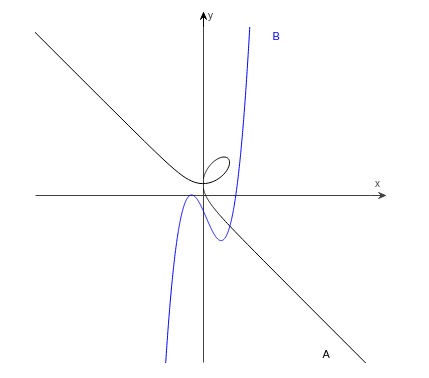
Using the vertical line test, we can see that B is a function as for every value on the x-axis, there is only a single y-value. This is not the case with function A as within the loop near the origin, there are points on the x-axis that correspond to multiple y-values. So, only B is a function.
By substituting in \(f(x)\) into the difference quotient equation, we get: \[\frac{\frac{x+h-2}{x+h+7}-\frac{x-2}{x+7}}{h}\] Multiplying by \((x+h+7)(x+7)\) to get rid of the improper fractions yields: \[\frac{(x+7)(x+h-2)-(x-2)(x+h+7)}{h(x+h+7)(x+7)}\] Simplifying completely yields: \[\frac{(x^2+xh-2x+7x+7h-14)-(x^2+xh+7x-2x-2h-14)}{h(x+h+7)(x+7)}\] \[\frac{x^2+xh+5x+7h-14-x^2-xh-5x+2h+14}{h(x+h+7)(x+7)}\] \[\frac{9h}{h(x+h+7)(x+7}\] Reducing \(h\) yields the final answer: \[\frac{9}{(x+h+7)(x+7)}\] Another acceptable answer would be to fully simplify out the denominator by multiplying everything out, but this is not necessary and could potentially introduce mistakes.
Substituting in \(f(x)\) into the differenece quotient yields: \[\frac{(1+h)^2-1-(1^2-1)}{h}\] Simplifying out the term that results from \(f(1)\) since \(f(1)=0\): \[\frac{(1+h)^2-1}{h}\] Multiplying out \((1+h)^2\): \[\frac{h^2+2h}{h}\] And simplifying the fraction completely yields the final answer: \[h+2\]

The actual value \(h(4)\) is equal to \(8\). The solid dot indicates the actual value of the function while the non-solid dot indicates a discontinuity at that point.
The value of the limit of \(h(x)\) as \(x\) approaches four is equal to six. There is a discontinuity here, but we are looking at what the value approaches as you come from the left and right hand sides.
The value of \(h(7)\) is undefined as there is a discontinuity at that point and there is no value of the function at that point.
The value of the limit of \(h(x)\) as \(x\) approachs seven is equal to 1.
The value of the limit of \(h(x)\) as \(x\) approachs eight is equal to 2 as the function is continuous there so the function is simply equal to the value of the limit.
Use the graph of \(g\) in the
figure to find the following values, if they exist. If a limit does not
exist, explain why. 
The value of the function at \(x=1\) is 3.
Looking from the left hand side, \(g(x)\) approachs 1 right before experiencing a discontinuity. Thus, \(\lim_{x\to1^-}g(x)=1\)
Looking from the right hand side, \(g(x)\) stays constant at 3 right before experiencing a jump discontinuity. Thus, \(\lim_{x\to1^+}g(x)=3\)
\(\lim_{x\to1}g(x)\) does not exist because the left hand and right hand limits are equal to different values.
\(g(2)\) is equal to 2.
\(\lim_{x\to2^-}(g(x)\) is equal to 3. The left hand side of \(g(x)\) near \(x=2\) is 3, right before experiencing a jump discontinuity at \(x=2\).
\(\lim_{x\to2^+}g(x)\) is equal to 2. The right hand side of \(g(x)\) near \(x=2\) is 2, right before experiencing a jump discontinuity at \(x=2\).
\(g(3)\) is equal to 3.
\(\lim_{x\to3}g(3)\) is equal to the value of the function at that point as the function is continuous there and thus the left hand and right hand limits approach the value of the function there.
If \(\lim_{x\to5}f(x)=\lim_{x\to5}h(x)=12\), find \(\lim_{x\to5}g(x)\) when \(f(x)\le g(x) \le h(x)\) for all values of \(x\).
Solving this problem involves an application of the squeeze theorem. The squeeze theorem states that if the following conditions are met: 1. \(g(x)\lt f(x) \lt h(x)\) for all numbers in an interval \(I\) 2. \(a\) is in the interval \(I\) 3. \(\lim_{x\to a}g(x)=\lim_{x\to a}h(x) = L\)
Then \(\lim_{x\to a}f(x)=L\) We are looking for the limit at \(x=5\), the functions follow the inequality for all real numbers, 5 is in the set of all real numbers, and thus \(\lim_{x\to 5}f(x)=12\)
To evalute this limit, \(\lim_{x\to-2^-}g(x)\), we need to use the first part of the piecewise function, which is just set to 0, because we are approaching from the left hand side, so we are inputting x-values that are slightly less than -2. Then we get \(\lim_{x\to2^-}g(x)=0\).
To evalute this limit, \(\lim_{x\to-2^+}g(x)\), we need to use the middle section of the piecewise function, \(-2<x<2\) as we are approaching 2 from the right and interested in x-values slightly bigger than -2. Then we get: \[\lim_{x\to-2^+}g(x)=\lim_{x\to-2^+}\sqrt{4-x^2}\] Using direct substitution yields: \[\lim_{x\to-2^+}\sqrt{4-4}=0\]
To evalute the actual limit, we need to compare the left and right limits. Since they are both equal to zero, \(\lim_{x\to-2}g(x)\) is also equal to zero.
To evalute the limit \(\lim_{x\to2^-}g(x)\), we need to use the second section of the piecewise function \(-2<x<2\) as we are interested in values slightly less than 2. This means that: \[\lim_{x\to2^-}g(x)=\lim_{x\to2^-}\sqrt{4-x^2}=0\]
To evalute the limit \(\lim_{x\to2^+}g(x)\), we need to use the third section of the piecewise function bounded by the inequality \(x\gt2\) as we are interested in values slightly greater than two. This means that: \[\lim_{x\to2^+}g(x)=\lim_{x\to2^+}5x=10\]
The left hand and right hand limits do not equal each other at \(x=2\) and thus the limit does not exist.
Evaluate the following limit: \[\lim_{h\to0}\frac{\sqrt{11h+1}-1}{h}\]
Solving by direct substitution does not work as the denominator would equal zero which would make the entire expression undefined. Start off by rationalizing the denominator by multiplying by the reciprocal of the numerator (limit is eliminated temporarily for simplicity): \[\frac{\sqrt{11h+1}-1}{h}\cdot\frac{\sqrt{11h+1}+1}{\sqrt{11h+1}+1}\] \[\frac{11h}{h\sqrt{11h+1}+h}\] \[\frac{11h}{h(\sqrt{11h+1}+1)}\] \[\frac{11}{\sqrt{11h+1}+1}\] Now, directly evaluating the limit by substitution: \[\lim_{h\to0}\frac{11}{\sqrt{1}+1}=\lim_{h\to0}\frac{11}{2}\]

The function diverges to infinity at \(x=-3\) when approached from the left hand side. Thus \(\lim_{x\to-3^-}f(x)=\infty\)
The function diverges to negative infinity at \(x=-3\) when approached from the right hand side as evidenced by the graph. Thus \(\lim_{x\to-3^+}f(x)=-\infty\).
The limit at \(x=-3\) does not exist and is not \(\infty\) or \(-\infty\) as the left hand and right hand limits do not equal each other.
The limit at \(x=2\) when approached from the left hand side is \(-\infty\) as evidenced by the graph.
The limit at \(x=2\) when approached from the right hand side is \(-\infty\) as evidenced by the graph.
The limit at \(x=2\) does not exist, but it does equal \(-\infty\) as both the left hand and right hand limits at \(x=2\) equal \(-\infty\)
Give the three conditions that must be satisfied by a function to be continuous at a point The three conditions that must be met for a function, \(f\), to be continuous at a point, \(a\), are the following:
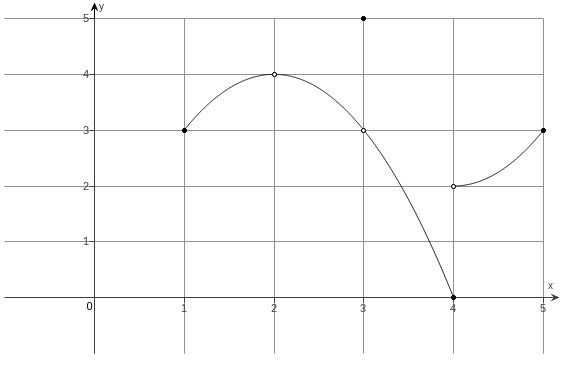
The function is not continuous at the following points: 1. \(x=2\) because \(f(x)\) is not defined at \(x=2\) 2. \(x=3\) because \(\lim_{x\to 3}f(x)\ne f(3)\), violating the third rule of the checklist. 3. \(x=4\) because \(\lim_{x\to 4}f(x)\) does not exist due to the presence of a jump discontinuity.
MathXL wants to make sure that you enter in that all the points violate the third condition of the checklist.
\(f\) is not continous at 0 because the limit does not exist at 0. \[\lim_{x\to0^-}f(x)=\lim_{x\to0^-}x^3+4x+3=(0)^3+4(0)+3=3\] \[\lim_{x\to0^+}f(x)=\lim_{x\to0^+}2x^3=2(0)^3=0\] \[\lim_{x\to0^-}f(x)\ne \lim_{x\to0^+}f(x)\] Since the left and right hand limits do not equal each other, the limit does not exist.
\(f\) is continuous from the left at zero due to the fact that the some piece of the piecewise function is used to define \(f\) when \(x \lt 0\) and when \(x=0\).
The function is continuous on the following intervals: \((-\infty,0)\) and \((0,\infty)\). Finding this just involves finding the points where the function is not continous and then working around them. Not that MathXL wants these answers in the form of a list, so taking the union of these two sets will result in MathXL marking the answer incorrect.
Suppose \$5000 is invested in a savings account for 13 years (156 months), with an annual interest rate of \(r\), compounded monthly. The amount of money in the account after 13 years is equivilant to the following equation: \[A(r)=5000\left(1+\frac{r}{12}\right)^{156}\]
To use the Intermediate Value Theorem, we first need to esbalish continuity over the interval of interest, specifically \((0,0.08)\). The functions is continuous over all real numbers due to the nature of exponential functions like this one, thus it is continuous over the interval of interest. Now, we need to find \(f(a)\) and \(f(b)\). \[A(0)=5000\left(1+\frac{0}{12}\right)^{156}=5000\] \[A(0.08)=5000\left(1+\frac{0.08}{12}\right)^{156}\approx14097.35\] Because \(A(0) < 7000 < A(0.08)\), and \(A(r)\) is continous over the ineterval of interest, there must be a value \(r\) in the interval \((0,0.08)\) such that \(A(r)=7000\) by the Intermediate Value Theorem.
A graph of the function of interest:
from matplotlib import pyplot
import numpy
import math
%matplotlib inline
x=numpy.arange(0, 0.08, 0.001)
x1=numpy.arange(0, 0.08, 0.001)
a = lambda r: 5000*(1+r/12)**156
afun = numpy.vectorize(a)
y=afun(x)
y1=numpy.full(x1.shape, 7000)
fig=pyplot.figure()
ax=fig.add_axes([0,0,1,1])
ax.plot(x,y)
ax.plot(x1,y1)[<matplotlib.lines.Line2D at 0x7f905cc10ca0>]
from sympy import *
r = Symbol('r')
nsolve(5000*(1+r/12)**156-7000,r,0.01)\(\displaystyle 0.0259104124338061\)
We can assume continuity of the function over the interval. Next up, we need to evaluate the function at the left and right endpoints of the interval. 1. \(f(0)=\sqrt{0^4+38(0)^3+10}=\sqrt{10}\) 2. \(f(1)=\sqrt{1^4+38(1)^3+10}=\sqrt{49}=7\)
Thus since \(f(0) \lt 6 \lt f(1)\), and \(f(x)\) is continuous over the interval, we know that a solution exists using the intermediate value theorem. Finding solutions over the interval:
from sympy import *
x = Symbol('x')
nsolve(sqrt(x**4+38*(x**3)+10)-6,x,0.5)\(\displaystyle 0.874519380409724\)
Here is the graph, without the point, because I’m too lazy to figure out how to add that in.
from matplotlib import pyplot
import numpy
import math
%matplotlib inline
x=numpy.arange(0, 1, 0.005)
x1=numpy.arange(0, 1, 0.005)
f = lambda x: sqrt(x**4+38*(x**3)+10)
ffun = numpy.vectorize(f)
y=ffun(x)
y1=numpy.full(x1.shape, 6)
fig=pyplot.figure()
ax=fig.add_axes([0,0,1,1])
ax.plot(x,y)
ax.plot(x1,y1)[<matplotlib.lines.Line2D at 0x7f165430d610>]
Yes. Differentiability implies continuity.
No. A simple counterexample to this proposition is a cusp. A cusp is continuous, but it will not be differentiable.
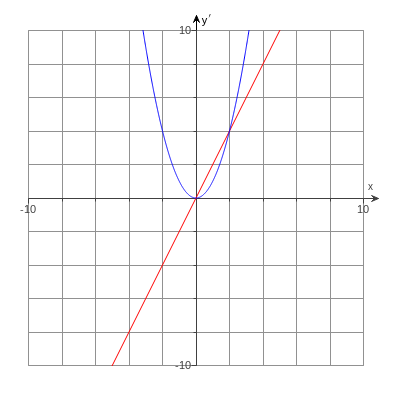
Just putting the answer here. With a problem like this, the easiest way to solve it on MathXL is to identify the function and then identify the derivative. The derivative of a quadratic function is always going to be linear, so this one must be the answer.
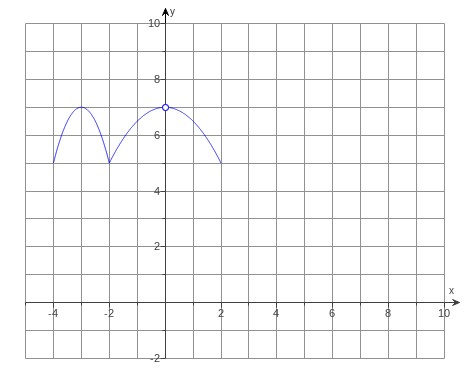

General guidelines for finding the correct graph: * Identify the nature of the functions in the graph of \(g\). In this case they are quadratic, so the sections of the derivative are going to be linear. * Make sure that all of the discontinuities are present in the derivative graph. * Make sure that where there are cusps in the original graph there are jump discontinuities in the graph of the derivative.
 Graphing is quite
simple. It is just two linear functions graphed, making sure to denote
what the function is equal to at the jump discontinuity with a filled in
circle and making sure to respect the conditions of the piecewise
function.
Graphing is quite
simple. It is just two linear functions graphed, making sure to denote
what the function is equal to at the jump discontinuity with a filled in
circle and making sure to respect the conditions of the piecewise
function.
For \(x<0\), \(f'(x)\) will be the derivative of \(-3x\), which is simply \(-3\).
For \(x>0\), \(f'(x)\) will be the derivative of \(-3x+2\), which is again \(-3\).
While the derivatives of the two sections of the piecewise function are equal to each other, the function is not continuous at \(x=0\) and thus it cannot be differentiable at \(x=0\).
Find the derivative of the following function: \[f(x)=9x^6-23x+e^4\]
To find the derivative of this function, we need to utilize the following rule. 1. When \(f(x)=x^n\), \(f'(x)=nx^{n-1}\). This is the power rule. We also need to make sure that we note that \(e^4\) is a constant. Applying the power rule yields the following: \[f(x)=(6)9x^{6-1}-(1)23x^{1-1}\] Simplifying out fully yields: \[f(x)=54x^5-23\]
Utilizing the distributive property to multiply everything out yields the following: \[g(r)=8r^3\cdot r^2+8r^3\cdot 6+7r\cdot r^2+7r\cdot 6+2\cdot r^2+2\cdot 6\] Simplifying the multiplication expressions yields: \[g(r)=8r^5+48r^3+7r^3+42r+2r^2+12\] Combining like terms: \[g(r)=8r^5+55r^3+2r^2+42r+12\] And then differentiating each term using the power rule yields the following: \[g'(r)=40r^4+165r^2+4r+42\]
These questions are asking us to find when the slope (derivative) is equal to specific values. So, finding the derivative is a logical first step. The derivative of the function can be taken by applying the power rule to each term: \[f'(x)=4x+8\] Now, we need to find then this derivative is equal to 0 and 4. 1. \(4x+8=0\), \(4x=-8\), \(x=-2\). 2. \(4x+8=-4\), \(4x=-12\) \(x=-3\).
Now, we need to plug these numbers back into the function since the problem is asking for points and not just \(x\) values at which these slopes occur. 1. \(2(-2)^2+8(-2)+5=-3\) 2. \(2(-3)^2+8(-3)+5=-1\) This means that the slope is equal to zero at the point \((-2,-3)\), and the slope is equal to -4 at \((-3,-1)\)
First off, let’s find the derivative of the expression given. We can simply use the constant multiple rule and the power rule, which yields: \[\frac{d}{dx}[3x+5g(x)]=3+5g'(x)\] We want to find the derivative at two, and plugging two into the equation yields: \[3+5*g'(2)=3+5*4=23\]
from sympy import *
t = Symbol('t')
nsolve(-16*(t**2)+266,t,4)\(\displaystyle 4.07737660757502\)
Now we also need to find the value of the derivative at this point. Rounding to 4.08 and plugging it into the original equation yields: \[-32(4.08)=-130.56\] This answer is in feet per second however and we need the answer to be in miles per hour. \[\frac{-130.56\text{feet}}{\text{second}}\cdot\frac{3600\text{seconds}}{1\text{hour}}\cdot\frac{1\text{mile}}{5280\text{feet}}\approx-89\]
Compute the derivative of the following function \[f(x)=7x+8xe^x\]
Computing the derivative for this function involves using the power rule for the first term, \(7x\), and using the product rule for the second term, \(8xe^x\). First off, finding the derivative of \(8xe^x\). \[8x\cdot e^x=\left(\frac{d}{dx}8x\right)e^x+\left(\frac{d}{dx}e^x\right)8x=8e^x+8xe^x\] Knowing this derivative, we can then find the derivative of the entire function. \[f'(x)=\frac{d}{dx}7x+\frac{d}{dx}8xe^x=7+8e^x+8xe^x\]
To find the value of this derivative, we just need to know the constant multiple rule and the quotient rule. Starting off by finding the derivative of the numerator: \[\frac{d}{dx}e^x=e^x\] Finding the derivative of the denominator: \[\frac{d}{dx}[9e^x-7]=9e^x\] Now, we can use the quotient rule: \[f'(x)=\frac{(9e^x-7)\frac{d}{dx}e^x-e^x\frac{d}{dx}[9e^x-7]}{(9e^x-7)^2}\] \[f'(x)=\frac{(9e^x-7)e^x-e^x\cdot9e^x}{(9e^x-7)^2}\] \[f'(x)=\frac{9e^{2x}-7e^x-9e^{2x}}{(9e^x-7)^2}\] \[f'(x)=\frac{-7e^x}{(9e^x-7)^2}\]
Finding the derivative by using the quotient rule: Derivative of the numerator \(2w^5-w\): \(10w^4-1\) Derivative of the denominator \(w\): \(1\) \[h'(w)=\frac{\frac{d}{dx}[2w^5-w]w-\frac{d}{dx}[w](2w^5-w)}{w^2}\] \[h'(w)=\frac{(10w^4-1)(w)-(2w^5-w)}{w^2}\] \[h'(w)=\frac{10w^5-w-2w^5+w}{w^2}\] \[h'(w)=\frac{8w^5}{w^2}\] \[h'(w)=8w^3\] Finding the derivative by first simplifying the function and then finding the derivative: \[\frac{w(2w^4-1)}{w}=2w^4-1\] \[\frac{d}{dx}[2w^4-1]=8w^3\] These results are the same no matter which method you use to find the derivative.
Computing the derivative of this function involves using the \(e^{kx}\) rule which is stated as follows: \[\frac{d}{dx}[e^kx]=ke^{kx}\] Applying this rule to \(f\) yields: \[f'(x)=2\cdot3e^{2x}=6e^{2x}\]
This part of the question is simply asking for the derivative. The \(e^{kx}\) rule is used again. \[Q'(t)=(-0.1386)29e^{-0.1386t}=-4.0194e^{-0.1386t}\]
This part is simply asking us to plug some values into the derivative. \[Q'(0)=-4.0194e^{-0.1386(0)}=-4.0194\] \[Q'(2)=-4.0194e^{-0.1386(2)}\approx-3.0463\]
Now, we need to evalute the limits. Since this is an exponential decay function and there is no constant term added to the function, the function tends towards zero as \(x\) tends towards infinity. The derivative also tends towards zero for the same reason.
Suppose the position of an object moving horizontally after \(t\) seconds is given by the following function: \(s=f(t)\), where \(s\) is measured in feet, with \(s \gt 0\) corresponding to positions right of the origin
Graphing the position function:
from matplotlib import pyplot
import numpy
import math
%matplotlib inline
x=numpy.arange(0, 8, 0.05)
f = lambda t: 4*(t**2)-7*t
ffun = numpy.vectorize(f)
y=ffun(x)
fig=pyplot.figure()
ax=fig.add_axes([0,0,1,1])
ax.plot(x,y)[<matplotlib.lines.Line2D at 0x7f1654200250>]
Finding the derivative of this function involves a straight forward application of the power rule. \[f'(t)=8t-7\] Graping this function yields:
from matplotlib import pyplot
import numpy
import math
%matplotlib inline
x=numpy.arange(0, 8, 0.05)
f = lambda t: 8*t-7
ffun = numpy.vectorize(f)
y=ffun(x)
fig=pyplot.figure()
ax=fig.add_axes([0,0,1,1])
ax.plot(x,y)[<matplotlib.lines.Line2D at 0x7f164bf6f6a0>]
The objection is stationary when the slope of the position function is zero, or when the derivative is equal to zero. \[8t-7=0;8t=7;t=\frac{7}{8}\] Finding when the object is moving to the right involves finding when the slope of the position function is positive, or when the derivative is positive. \[8t-7>0; 8t>7;t>\frac{7}{8}\] Putting this into interval notation, we get that the object is moving to the right over the interval \(\left(\frac{7}{8},8\right]\). Finding when the object is moving left involves finding when the slope of the position function is negative, or when the derivative is negative. \[8t-7<0; 8t<7; t<\frac{7}{8}\] Putting this into interval notation, we get \(\left[0,\frac{7}{8}\right)\). Make sure to note what values should be included in the intervals. In the case of this function, the endpoints of the domain are included since the domain interval is \([0,8]\). We do not include the point where the object is stationary in the left/right intervals. The velocity of the object at \(t=1\) is simply the value of the derivative of the position function when \(t=1\). Substituting everything in yields: \[8(1)-7=1\] Finding the acceleration involves finding the acceleration function. Taking the derivative of the velocity function \(8t-7\) yields the constant eight, which is the acceleration function for the given position function. The answer to acceleration at any point is thus 8.
Determining the velocity involves finding the velocity function. This again is a simple application of the power rule: \[s'(t)=-22t+110\]
The stone reaches its highest point at the vertex of the parabola that is described by the quadratic position function. This can be found using the \(x=\frac{-b}{2a}\) trick, or by finding a critical point using the derivative. \[-22t+110=0;22t=110;t=5\]
The height of the stone at its highest point simply involves susbtituting the x value of the vertex into the position function. \[-11(5)^2+110(5)+110=-275+550+110=385\]
The stone strikes the ground at the zero of the position function tht is within a reasonable domain. Since the expression is not factorable, I will be using the quadratic formula: \[\frac{-110\pm\sqrt{110^2-4(-11)(110)}}{2(-11)}\] \[\frac{-110\pm\sqrt{16940}}{-22}\] \[\frac{-110\pm\sqrt{484}\sqrt{35}}{-22}\] \[\frac{-110\pm22\sqrt{35}}{-22}\] Switching over to only looking at the positive root: \[\frac{-110+22\sqrt{35}}{-22}\] \[5+\sqrt{35}\]
Finding the velocity of when the stone strikes the ground simply involves plugging in the zero of the position function into the velocity function. \[-22(5+\sqrt{35}+110=-110-22\sqrt{35}+110=-22\sqrt{35}\]
Finding the intervals upon which the speed is increasing involves finding the intervals upon which the slope of the position function is getting steeper. The best way to do it for this problem is simply to take the downfall of the object because on the way up it is getting slower, and then take the vertex to the end point. This is approximately \((5,10.92)\) with \(10.92\approx5+\sqrt{35}\).
Determine whether the following statements are true or false and give an explanation or counter example.
This is false. If the acceleration is constant, then the velocity function has to be at least linear which is not constant.
True. The only way for the acceleration to be zero is if the velocity is constant.
This is false. For any continuous acceleration function, there should be a point where the instantaneous velocity equals the average velocity.
This is true. Speed is equal to the absolute value of velocity.
Find \(\frac{dy}{dx}\) \[y=\sin^{-1}{6x^5}\]
This problem involves the use of the inverse trig derivative rules and the chain rule. The derivative rule for \(sin^{-1}{x}\): \[\frac{d}{dx}\sin^{-1}{x}=\frac{1}{\sqrt{1-x^2}}\] Subtituting everything in and making sure to multiply by the derviative of the inner function(\(6x^5\)) to satisfy the chain rule, we get: \[\frac{1}{\sqrt{1-(6x^5)^2}}*30x^4\] Simplifying, we get: \[\frac{30x^4}{\sqrt{1-36x^10}}\]
The relevant inverse trig derivative rule: \[\frac{d}{dx}\tan^{-1}{x}=\frac{1}{1+x^2}\] Making sure to multiply by the constant multiple (\(8\)) and the derivative of the inner function (\(4x\)) to satisfy the chain rule, and substituting everything in yields: \[8\cdot\frac{1}{1+(4x)^2}\cdot4\] Simplifying further \[\frac{32}{1+16x^2}\]
The relevant inverse trig derivative rule: \[\frac{d}{dx}\cot^{-1}{x}=-\frac{1}{1+x^2}\] Making sure to respect the constant multiple (\(4\)), and satisfying by the chain rule by multiplying by the derivative of the inner function (\(\sqrt{6z}\)), and the derivative of the inner function of the inner function (\(6z\)), we get get the following: \[4\cdot-\frac{1}{1+(\sqrt{6z})^2}\cdot \frac{d}{dx}[\sqrt{6z}] \cdot 6\] Finding the derivative of \(\sqrt{6z}\): \[\sqrt{6z}=(6z)^{\frac{1}{2}}\] \[\frac{d}{dx}\left[(6z)^{\frac{1}{2}}\right]=\frac{1}{2}(6z)^{-\frac{1}{2}}=\frac{1}{2\sqrt{6z}}\] Substituting in and simplifying a little bit: \[\frac{-4}{1+6z}\cdot\frac{1}{2\sqrt{6z}}\cdot6\] \[\frac{-24}{1+6z}\cdot\frac{1}{2\sqrt{6z}}\] \[\frac{-12}{(1+6z)\sqrt{6z}}\]
The relevant inverse trig derivative rule: \[\frac{d}{dx}\tan^{-1}{x}=\frac{1}{1+x^2}\] Making sure to respect the chain rule and the constant multiple rule, we get: \[2\cdot\frac{1}{1+(e^{4x})^2}\cdot4e^{4x}\] Simplifying completely, we get: \[\frac{8e^{4x}}{1+e^{8x}}\]
The key to this problem is that the derivative of the inverse is equal to the reciprocal of the derivative. The derivative of this function is \(f'(x)=4\) based on the power rule and the constant rule. The reciprocal of the derivative is \(\frac{1}{4}\) which happens to be our answer in this situation.
Finding the inverse: \[y=x^4+2\] \[y-2=x^4\] \[\sqrt[4]{y-2}=x\] Rewriting in terms of \(f(x)\): \[f(x)=\sqrt[4]{x-2}\] Now, finding the derivative: \[\sqrt[4]{x-2}=(x-2)^{\frac{1}{4}}\] \[\frac{1}{4}\cdot(x-2)^\frac{-3}{4}\] This entire equation is multiplied by one because of the chain rule, but because 1 is the multiplicative identity, there is no change. \[\frac{1}{4(x-2)^\frac{3}{4}}\] \[\frac{1}{4\sqrt[4]{(x-2)^3}}\]
Finding the derivative: \[\frac{1}{1+(2x)^2}\cdot2\] \[\frac{2}{1+4x^2}\] Substituting in \(-1\): \[\frac{2}{1+4(-1)^2}\] \[\frac{2}{5}\]
Finding the derivative: \[8(6x+7)^7\cdot6\] The six that is multiplied by the rest of the equation is the derivative of the inner function, which is where the chain rule comes into play. \[48(6x+7)^7\]
The derivative of the inner function \(e^x\) is simply \(e^x\). Applying the chain rule: \[\sec^2(e^x)\cdot e^x\] \[e^x\cdot \sec^2(e^x)\]
Finding the derivative of \(h(x)\) using the chain rule: \(h'(x)=f'(g(x))\cdot g'(x)\). Finding the derivative of \(p(x)\) using the chain rule: \(p'(x)=g'(f(x))\cdot f'(x)\). Plugging in values from the table to find \(h'(4)\): \[h'(4)=f'(g(4))\cdot g'(4)=f'(3)\cdot\frac{4}{5}=-\frac{4}{5}\] Plugging in values from the table to find \(p'(2)\): \[p(2)=g'(f(2))\cdot f'(2)=g'(3)\cdot-8=-\frac{16}{5}\]
Finding the first derivative using the product rule: \[y'=7x\cdot\cos{x^2}\cdot2x+7\sin{x^2}\] Taking the derivative of the first time in that equation: \[7x\cdot\cos{x^2}\cdot2x=14x^2\cdot\cos{x^2}\] Using the product rule: \[14x^2\cdot-\sin{x^2}\cdot2x+28x\cdot\cos{x^2}\] \[-28x^3\sin{x^2}+28x\cdot\cos{x^2}\] Substituting in to find the big derivative: \[-28x^3\sin{x^2}+28x\cdot\cos{x^2}+7\cos{x^2}\cdot2x\] \[-28x^3\sin{x^2}+28x\cdot\cos{x^2}+14x\cos{x^2}\] \[42x\cos{x^2}-28x^3\sin{x^2}\]
from matplotlib import pyplot
import numpy
import math
%matplotlib inline
x=numpy.arange(0, 24, 0.05)
p = lambda t: 500+350*cos((pi*t)/12)
pfun = numpy.vectorize(p)
y=pfun(x)
fig=pyplot.figure()
ax=fig.add_axes([0,0,1,1])
ax.plot(x,y)[<matplotlib.lines.Line2D at 0x7f164b9cf760>]
Finding the implicit derivative: \[4x^3+32y^3\cdot y'=0\] \[32y^3\cdot y'=-4x^3\] \[y'=\frac{-4x^3}{32y^3}\] The slope of the curve at the point \((1,-2)\) is found through substitution as follows: \[\frac{-4(1)^3}{32(-2)^3}=\frac{-4}{32\cdot-8}=\frac{-4}{64\cdot-4}=\frac{1}{64}\]
MathXL presents the first part of this problem always as a multiple choice problem, and you need to choose the one that satisfies all the conditions of the equation. For the second part, we need to start off by implicitly differentiating: \[4x+xy'+y+2y\cdot y'=0\] \[xy'+2y\cdot y'=-4x-y\] \[y'(x+2y)=-4x-y\] \[y'=\frac{-4x-y}{x+2y}\] Substituting in the point values to get the slope: \[y'=\frac{-4(3)-1}{3+2}=\frac{-13}{5}\] Plugging everything into point slope form: \[y-1=-\frac{13}{5}(x-3)\] Simplifying into point intercept: \[y=-\frac{13}{5}x+\frac{39}{5}+1\] \[y=-\frac{13}{5}x+\frac{44}{5}\]
Finding the derivative using the power rule and the chain rule: \[\frac{-6}{5}(5x-7)^{\frac{-11}{5}}\cdot5\] \[\frac{-6\cdot5}{5(5x-7)^{\frac{11}{5}}}\] \[\frac{-6}{(5x-7)^{\frac{11}{5}}}\] \[\frac{-6}{\sqrt[5]{(5x-7)^{11}}}\]
Using the chain rule and the power rule: \[9(6x+5)^8\cdot6=54(6x+5)^8\]
from matplotlib import pyplot
import numpy
import math
%matplotlib inline
x=numpy.arange(0, 50, 0.05)
a = lambda s: 2*s*5
afun = numpy.vectorize(a)
y=afun(x)
fig=pyplot.figure()
ax=fig.add_axes([0,0,1,1])
ax.plot(x,y)[<matplotlib.lines.Line2D at 0x7f164b9a6a30>]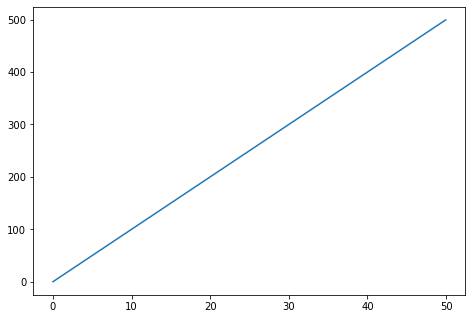
The area can be expressed in terms of \(r\) with the following equation: \(a=\pi r^2\). Differentiating this equation, we get: \[a'=2\pi r \cdot r'\] Substituting in \(0.03\) for \(r'\) and \(41\) for \(r\): \[a'=2\pi 41 \cdot 0.03=2.46\pi\]
Expressing the distance from the origin involves the use of the Euclidean distance metric: \[d=\sqrt{x^2+y^2}\] Expressing in terms of solely \(d\) and \(x\) so that we can take a single variable derivative: \[d=\sqrt{x^2+(x^2)^2}\] \[d=\sqrt{x^2+x^4}\] Implicitly differentiating: \[d'=\frac{1}{2}(x^2+x^4)^{-\frac{1}{2}}\cdot(2x\cdot x' + 4x^3 \cdot x')\] \[d'=\frac{2x \cdot x' + 4x^3 \cdot x'}{2\sqrt{x^2+x^4}}\] Plugging in \(4\) for \(d'\), and \(3\) for \(x\) and then solving: \[4=\frac{6\cdot x' + 108 \cdot x'}{2\sqrt{9+81}}\] \[4=\frac{114 \cdot x'}{2\sqrt{90}}\] \[4=\frac{57 \cdot x'}{\sqrt{90}}\] \[4\sqrt{90}=57x'\] \[12\sqrt{10}=57x'\] \[x'=\frac{12\sqrt{10}}{57}\] Expressing solely in terms of \(d\) and \(y\): \[d=\sqrt{y+y^2}\] Implicitly differentiating: \[d'=\frac{1}{2}(y+y^2)^{-\frac{1}{2}}\cdot(y'+2y\cdot y')\] \[d'=\frac{y'+2y\cdot y'}{2\sqrt{y+y^2}}\] Plugging in \(9\) for \(y\) and \(4\) for \(d'\) \[4=\frac{y'+18y'}{2\sqrt{9+81}}\] \[4=\frac{19y'}{2\sqrt{90}}\] \[19y'=8\sqrt{90}\] \[y'=\frac{8\sqrt{90}}{19}\] \[y'=\frac{24\sqrt{10}}{19}\]